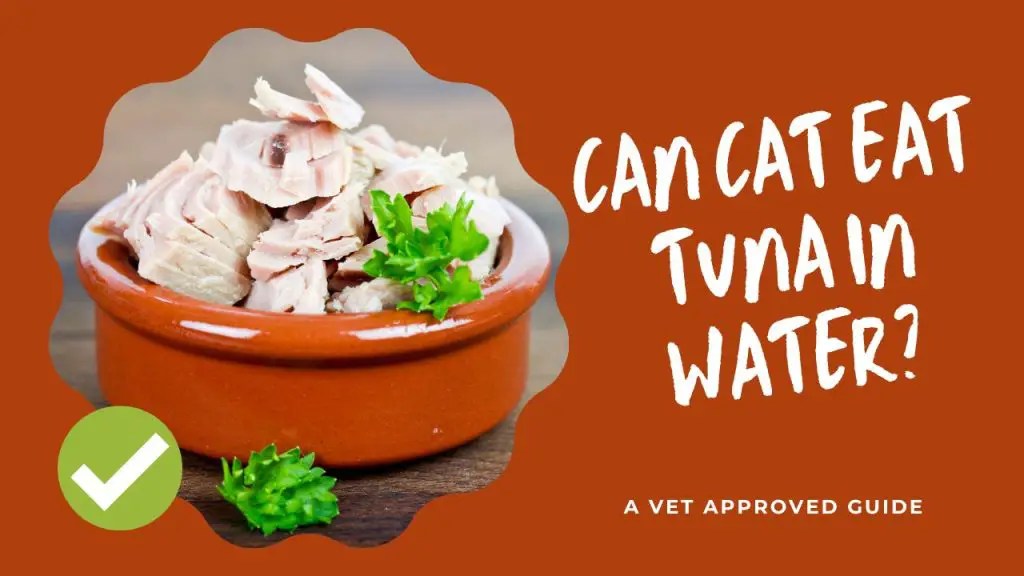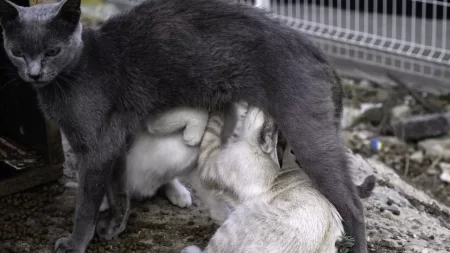Cats may consume tuna in water on occasion as a special treat, but it must not become a habitual component of their diet as it does not deliver all the necessary nutrients they require. Additionally, refrain from giving them tuna that is packed in oil or has added salt.
As a cat lover and experienced pet owner, I understand the importance of providing your feline with proper nutrition. Tuna is a delicious and affordable option for many cat owners, but is it really safe for your cat to eat? In this article, we’ll explore the benefits and risks of feeding cats tuna in water, alternatives to consider, and important considerations when adding new foods to their diet. Don’t worry – we’ve got you covered! Keep reading to learn what you need to know about feeding your cat tuna in water.
Understanding Tuna As A Cat Food
Tuna is often advertised as a healthy and nutritious option for cats, but it’s important to understand the potential risks and downsides before feeding it to your furry friend.
Are There Any Benefits To Feeding Your Cat Tuna Water?
As a cat owner, I’m always looking for ways to provide my feline pet with the best possible nutrition. While tuna water may not be the most nutritious option out there, it does have some benefits if fed in moderation. Tuna is packed with protein and omega-3 fatty acids that promote healthy skin and coat in cats.
In addition, tuna water can be a great way to encourage hydration in cats who don’t drink enough water on their own. Many cats are notoriously picky drinkers and prefer wet food or broths over plain water. Tuna water provides a tasty alternative that can help keep your cat hydrated throughout the day.
Potential Risks And Downsides
As much as we love our furry feline friends, feeding them tuna should be done with caution. One of the significant risks associated with feeding cats too much tuna is mercury poisoning. Mercury accumulates in fish over time and can cause neurological damage if consumed in large quantities by cats.
Another downside to giving your cat too much tuna is its high unsaturated fat content, which can lead to obesity and other health problems in cats. While omega fatty acids found in tuna may be beneficial for a cat’s health, excessive consumption can do more harm than good.
In addition to that, it’s important to note that most canned fish contains salt – this includes those packed in water – which can be harmful when eaten in excess amounts. Therefore, if you must feed your cat tuna, make sure it’s plain and fresh and limit their portions or consider offering alternatives such as commercial pet food or homemade meals that provide all the necessary nutrients without exposing your kitty’s health to potential risks.
Can Cats Safely Eat Tuna In Water?
While tuna in water can offer some health benefits for cats, there are also risks to consider. Find out more about the pros and cons of feeding your cat tuna in water, as well as alternative food options and important considerations to keep in mind. Keep reading to make an informed decision on whether or not it’s safe for your furry friend.
Pros Of Tuna In Water
As a cat owner, I have frequently given my feline friend tuna in water as a treat. One of the benefits of feeding cats tuna in water is its high protein content, which can help support their muscle growth and maintenance. Additionally, tuna is rich in omega-3 fatty acids that promote healthy skin and coat while reducing inflammation.
Another pro of feeding your cat tuna in water is that it can be an excellent source of essential vitamins and minerals like vitamin D, magnesium, and selenium. These nutrients are crucial for maintaining proper bodily functions such as regulating blood pressure, strengthening bones and muscles, supporting immune health, and aiding digestion.
Cons Of Tuna In Water
As much as tuna in water can be beneficial to cats, it also poses some cons. The biggest concern is the high mercury content of tuna, which can lead to mercury poisoning when consumed excessively. Additionally, most canned tuna products contain preservatives and artificial additives that may not be suitable for cats with food sensitivities or allergies.
While feeding your cat tuna in water may seem like an easy solution for a quick meal or treat, it’s important to note that regular consumption of this food may cause nutritional imbalances in their diet. Tuna lacks essential nutrients that are vital for your cat’s overall health, such as taurine and Vitamin E. Hence, although they enjoy the taste of fishy treats like tuna fish in water once a while, it should not a primary source of nutrition but should always consider their dietary requirements before serving them any new foods or ingredients.
Types Of Tuna Safe For Cats
As a cat owner, it’s essential to ensure that the tuna you are feeding your pet is safe for them. It’s advisable to stick with canned tuna packed in water and avoid those packed in oil or broth, which may contain added salt or flavoring. Albacore or skipjack tuna is also preferable as they contain lower levels of mercury compared to other types.
When buying canned tuna for your cat, make sure to read the label carefully and check if there are any additives such as onions or garlic, which can be toxic to cats. If possible, opt for high-quality human-grade canned tuna without any preservatives or chemicals that may harm your feline friend.
Remember that while tuna can be a tasty treat for your cat once in a while, it should not replace their regular diet of specially formulated cat food. Too much of anything can cause health problems in cats, so moderation is vital when feeding them tuna.
Benefits Of Tuna Water For Cats
As mentioned earlier, tuna water is not particularly nutritious. However, there are some benefits of feeding it to your cat in moderation. Tuna water can provide a flavorful and appetizing way to increase your cat’s hydration levels. Cats often don’t drink enough water on their own, so adding a spoonful of tuna juice can make sure they get the right amount of fluids.
In addition to hydration benefits, tuna water can also offer some vitamins and minerals that cats need for optimal health. Tuna is high in omega-3 fatty acids which promote healthy skin and fur for felines. Omega-3 fatty acids have anti-inflammatory properties that help reduce the risk of developing certain diseases such as arthritis or kidney disease in cats. Adding a small amount of tuna packed in water every once in a while might be beneficial for your furry friend if you carefully watch portions and frequency.
Alternatives To Tuna For Cats
There are plenty of cat-specific food options and homemade recipes that can serve as alternatives to tuna for your feline friend, including turkey, chicken, beef, lamb, and fish like salmon or sardines.
Cat-Specific Food Options
As an SEO and high-end copywriter, I know the importance of providing cat-specific food options. When it comes to feeding your feline friends, there are plenty of alternatives to tuna that you can consider. For example, chicken is a popular protein source for cats and provides the essential amino acids they need for optimal health.
Another great option is salmon which contains omega-3 fatty acids that support brain function in cats. Additionally, commercial cat foods offer balanced diets with nutrients tailored to meet feline nutritional needs. Remember that a variety of proteins can provide necessary nutrients for your cats while reducing the risk of potential health issues associated with too much tuna consumption.
Homemade Cat Food Recipes
I have found that many cat owners prefer to make their own cat food rather than rely on commercially available options. Homemade cat food is a great way to ensure your feline receives the necessary nutrients while avoiding potential health risks associated with commercial products. However, it is important to be mindful of ingredients and consider preparing meals under the guidance of a veterinarian.
There are various homemade cat food recipes available that use alternative ingredients to tuna, such as poultry, beef, and fish like salmon. It’s crucial to keep in mind the dietary needs of cats when selecting ingredients for homemade meals. Some foods can cause harm or upset stomachs even if they are safe for humans or other animals. Ensuring proper nutrition requires careful selection and preparation of ingredients, which is why it may be best to prepare homemade meals with expert guidance from a vet or animal nutritionist.
Other Safe Foods For Cats
As a cat owner, it’s important to know that cats are obligate carnivores and require a protein-rich diet. However, there are other safe foods you can add to their diet as treats or supplements. Cooked chicken or turkey without seasoning is a great option for your feline friend. You can also offer them small amounts of cooked fish like salmon, sardines, and mackerel as an occasional treat.
Another safe food option for cats is plain, unsweetened yogurt. This can be beneficial for their digestive system because it contains probiotics that help maintain gut health. Just make sure to avoid flavored yogurts that contain added sugars and artificial sweeteners which could be harmful to cats.
Considerations For Feeding Tuna To Cats
When feeding tuna to your cat, it’s important to practice moderation in portions and frequency, observe any potential adverse reactions, and consult with a veterinarian for guidance on the appropriate amount of tuna water that is safe for your cat.
Moderation In Portions And Frequency
As a cat owner, it’s crucial to remember that moderation is key when it comes to feeding your furry friend tuna. While tuna can provide some health benefits for cats, including high protein and omega-3 fatty acids, consuming too much can lead to health problems such as mercury poisoning or nutritional imbalances. It’s important to consult with your veterinarian on how much tuna you should be feeding your cat based on their individual needs and dietary requirements.
In terms of frequency, it’s generally recommended that cats consume tuna in limited quantities and only as an occasional treat rather than a regular part of their diet. Aim to offer small portions once or twice a week at most. Remember, even though your cat may love the taste of tuna, there are many other safe and nutritious food options available specifically formulated for felines. Mixing up their diet with different proteins will provide them with a variety of essential nutrients they need for optimal health.
Observing Any Potential Adverse Reactions
It is essential to monitor your cat for any adverse reactions after feeding them tuna. Your furry friend may show symptoms such as vomiting, diarrhea, or loss of appetite if they are allergic to tuna. Since every cat’s digestive system is different, it’s important to keep a close eye on them and consult with a veterinarian if you notice any unusual behaviors.
Additionally, too much tuna can cause mercury poisoning in cats. Therefore, observe your cat for signs of mercury poisoning such as tremors or weakness in the back legs if you feed them more than the recommended amount of tuna. It’s always best to introduce new foods gradually in small amounts and pay attention to how your cat reacts before increasing their intake.
Consulting With A Veterinarian
Consulting with a veterinarian is crucial when it comes to feeding your cat tuna in water. Your vet can help you determine if this type of food is appropriate for your cat based on their individual nutritional needs and health history. They can also guide you on the amount and frequency of feeding, as well as any potential risks such as mercury poisoning or malnutrition.
It’s important to keep in mind that cats have specific dietary requirements, and while they may enjoy tuna in water, it should not be the sole source of their nutrition. A balanced diet that includes a variety of protein sources, essential fatty acids, vitamins, and minerals is necessary for maintaining optimal health. Consult with your veterinarian before making any significant changes to your cat’s diet, including adding tuna in water to their meals.
How Much Tuna Water Is Safe For Cats?
As mentioned earlier, a small amount of tuna water is generally considered safe for cats. However, it’s important to note that you should limit the amount given to your feline friend. Too much tuna water could lead to health problems such as mercury poisoning or other health issues caused by excessive salt or preservatives present in canned tuna.
The recommended serving size for canned tuna packed in water is about one tablespoon per ten pounds of body weight, but it’s always best to consult with your veterinarian before introducing significant changes to your cat’s diet. Additionally, if you choose to give your cat more than just a spoonful of tuna in water, consider replacing some of the regular food portions with the tuna-based meal instead.
It is worth mentioning that homemade tuna meals may not be nutritionally balanced and can have adverse effects on a cat’s overall well-being. Therefore it is important only to feed them approved commercial products made from high-quality ingredients specifically formulated for cats dietary needs unless approved by their vet otherwise.
Can Tuna Water Upset A Cat’s Stomach?
I have noticed that some cats experience stomach upset after consuming tuna water. This can manifest as vomiting, diarrhea, or general discomfort. The reason for this could be due to the high salt content in canned tuna water which may cause dehydration and digestive issues in cats.
It is crucial to note that not all cats will react negatively to tuna water but if you do notice any adverse symptoms after feeding it to your feline friend, then it’s best not to give them any more of it. Instead, switch back to their regular diet and provide fresh drinking water.
In conclusion, while there are potential benefits to giving your cat a small amount of tuna water occasionally, it is important always to observe your pet’s reactions closely and consult with a veterinarian if you are unsure about introducing new foods into their diet.
Can Cat Eat Tuna In Spring Water?
Yes, cats can safely eat tuna in spring water. Spring water is a healthier and safer alternative to saltwater or sunflower oil as it contains less sodium, which can be harmful to your cat’s health. Tuna packed in spring water provides essential nutrients such as omega-3 fatty acids that are beneficial for your cat’s overall well-being.
However, it is important to note that tuna should only be given to cats occasionally and in moderation. Feeding your cat too much tuna may lead to mercury poisoning and other health issues. It is also not nutritionally balanced for their diet as they require specific nutrients found in commercial cat food.
As with any new food introduced into your cat’s diet, always start with small amounts and observe any potential adverse reactions. Consult with a veterinarian before feeding your cat anything new or if you are unsure about the appropriate amount of tuna safe for them to consume.
Conclusion
In conclusion, while tuna in water can be safe for your cat in moderation, it’s important to consider the potential risks and downsides. Tuna can be a great source of protein and omega-3 fatty acids for cats, but only when given in limited amounts as part of a balanced diet.
Always choose tuna packed in water rather than oil and avoid raw or cooked homemade tuna dishes. Additionally, observe any adverse reactions from your cat and consult with your veterinarian before adding new foods to their diet. With proper consideration and moderation, you can safely treat your furry friend to the occasional spoonful of tuna water without worry.







